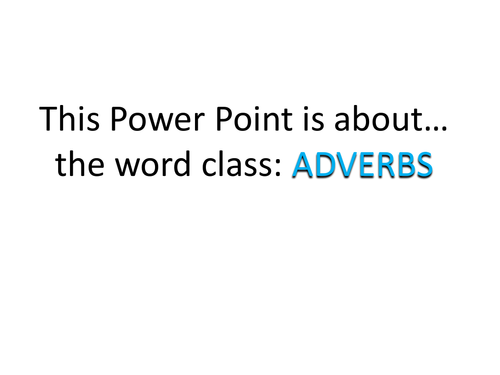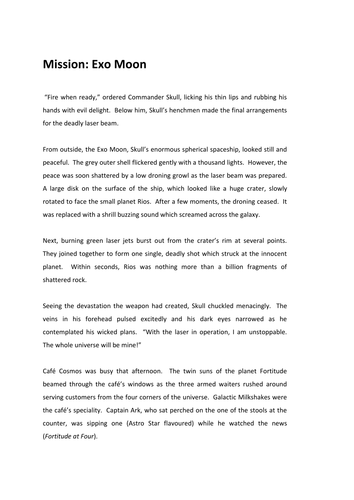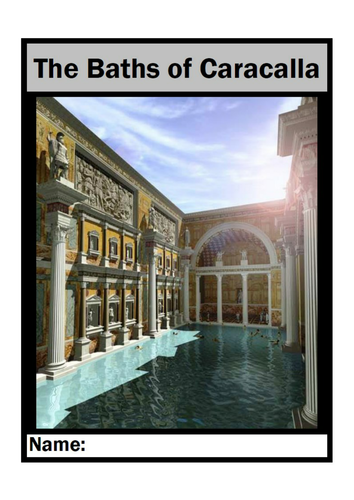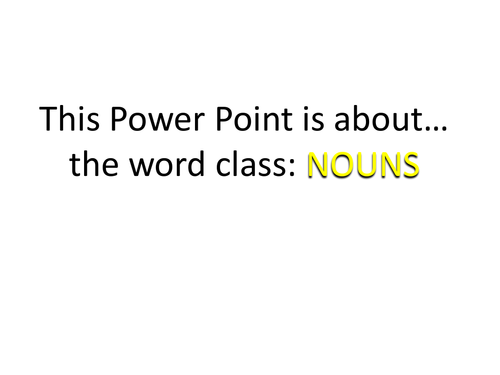
27Uploads
29k+Views
6k+Downloads
All resources

Grammar Explained: Adverbs
A Power Point which explains the function of adverbs.
A task sheet with questions about adverbs. An exercise for students to complete after the presentation. Answers are included.
You can purchase the whole set of these Power Points (11 in total) about different grammar points or punctuation marks. It’s a resource called ‘Grammar & Punctuation Explanations’. There’s also a whole set of task sheets like the one here with each exercise corresponding to the Power Point. It’s called ‘Grammar & Punctuation Exercises’.

Narrative Writing: Crooked
When Ludwig and Marta find a map in their new house’s cellar, they begin an adventure which takes them to a ruined castle and a terrifying crooked man!
A long-ish quest / suspense narrative (8 pages) which could be used for guided or shared reading or as a modelled text to teach a variety of objectives (see Teaching Points below). There is a set of KS2 SAT style comprehension questions based on the text.
Teaching Points:
GRAMMAR: past tenses (including past perfect); fronted adverbials; adjectives and adverbs for descriptive detail; connectives (contrast and time); relative clauses; 3rd person narration
PUNCTUATION: commas around clauses; exclamation and question marks; speech marks; ellipsis; colons and semi-colons
STRUCTURE: paragraphing, including short paragraphs and sentences for dramatic effect; balance of action, dialogue and setting; repetition of phrases for effect
CONTENT & THEME: quest, suspense narrative; character (villain, brother-sister); resolution with surprise; rhetorical questions; figurative language (simile, metaphor, alliteration)

Narrative Writing: Exo Moon
Can Captain Ark and his crew stop Commander Skull from destroying the galaxy?
The beginning of a science fiction (think Star Wars) narrative (2.5 pages) which could be used for guided or shared reading, as a modelled text or as an opening prompt for students to continue.
Teaching Points:
GRAMMAR: past tenses; fronted adverbials; adjectives and adverbs for descriptive detail; connectives (contrast and time); relative clauses; 3rd person narration
PUNCTUATION: commas around clauses; exclamation and question marks; speech marks; brackets
STRUCTURE: paragraphing, balance of action, dialogue and setting
CONTENT & THEME: science-fiction; character (hero, villain); figurative language (simile)

Snow Day: Snowbound Texts
After a heavy snowstorm, staff and students at a school have been forced to spend the night, entirely cut off from the outside world…
Here are 5 texts which describe the experience:
It’s Snowing!: a story describing the the reaction of students as the snow begins to fall at school.
Night: a poem describing the atmosphere as students try to sleep in a classroom.
A Search Party: a discussion text outlining arguments for and against sending out a search party to look for help.
Expedition: an action story in which a search party attempt to brave the outside.
Safe at Last!: a news report detailing the rescue of the staff and students.
All brilliantly illustrated by Nick Hilditch
These texts could be used in a variety of ways:
exploring and comparing different text types or genres;
texts for whole class or guided reading;
the basis of reading comprehensions;
modelled texts for students’ own writing.
Language features:
Narrative Writing: past tenses, including past perfect; fronted adverbials; adjectives and adverbs for descriptive detail; coherence; relative clauses; commas around clauses; semi-colons; colons; ellipsis; inverted commas; paragraphing, including short paragraphs and sentences for dramatic effect; balance of action, dialogue and setting; themes of adventure, rescue, overcoming fear; character description; figurative language (simile, metaphor).
Poetry: metaphor; figurative language; personification; contrasts; patterns; alliteration; repetition.
Discussion: formal writing; direct address; objectivity; quotations; sentence adverbs; punctuation range.
News Report: layout; report structure; direct and reported speech; formal language.

Fractions Simplification Game
A simple but effective game which teaches and revises various aspects around simplifying fractions.
Pupils play in teams. They choose a category from the game board. The PowerPoint will throw up a question about the chosen area and reveal the answer when clicked.
This activity can easily last a whole one hour lesson. Pupils enjoy the competitive element.
Topics covered in the game: fractions; simplifying; factors; multiples; prime numbers; explaining answers; reasoning problems.

Report Booklet: The Roman Baths of Caracalla
A 16 page non-chronological report booklet on the Roman Baths of Caracalla in Rome.
It contains a report, pictures, a map and several question pages.
It could be printed out as a pamphlet for students to use as a guided reading resource or when studying non-chronological reports.
Teaching Points:
GRAMMAR: past and present tenses; direct questions to the reader; relative clauses; complex sentences
PUNCTUATION: exclamation marks; questions marks; commas around clauses; brackets; semi-colons
STRUCTURE: paragraphs with sub-headings; labelled pictures and diagrams
CONTENT & THEME: historical report; specific vocabulary (eg Latin); persuasive language

Grammar Explained: Nouns
A Power Point which explains the function of nouns in sentences. It includes information on different types of noun (common, proper, abstract, concrete, collective).
A task sheet with questions about nouns. An exercise for students to complete after the presentation. Answers are included.
There is a whole set of these Power Points (11 in total) about different grammar points or punctuation marks. It's a resource called 'Grammar & Punctuation Explanations'. There's also a set of task sheets like the one here with each exercise corresponding to the Power Point. It's called 'Grammar & Punctuation Exercises'.







